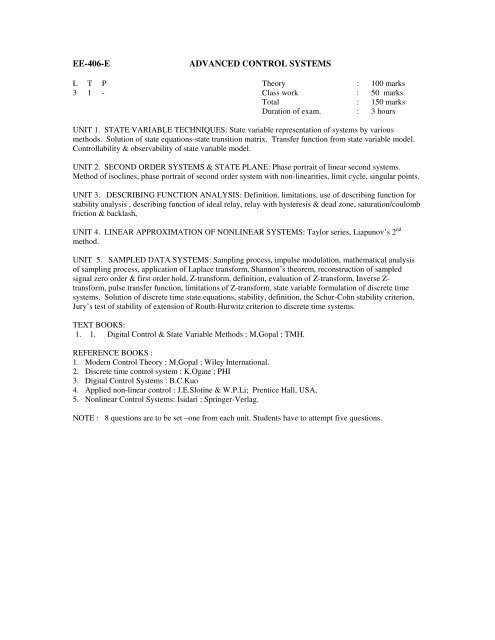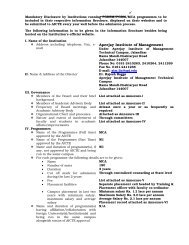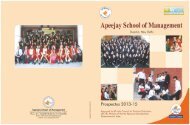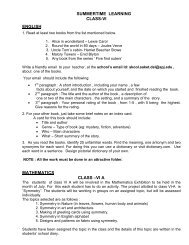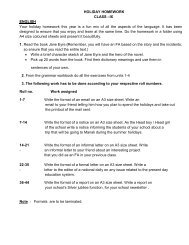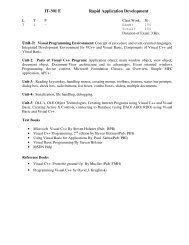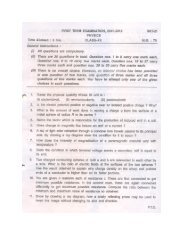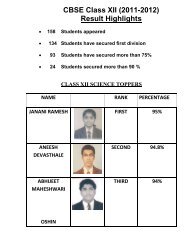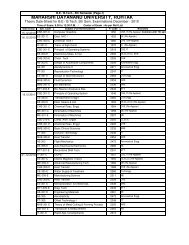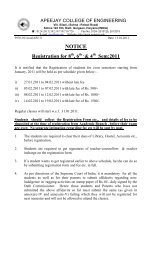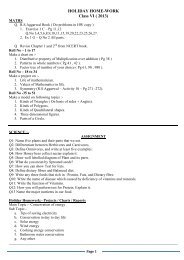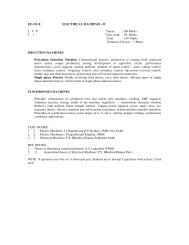EE-406-E ADVANCED CONTROL SYSTEMS
EE-406-E ADVANCED CONTROL SYSTEMS
EE-406-E ADVANCED CONTROL SYSTEMS
Create successful ePaper yourself
Turn your PDF publications into a flip-book with our unique Google optimized e-Paper software.
<strong>EE</strong>-434-E<strong>ADVANCED</strong> INSTRUMENTATIONL T P3 1 - Exam. : 100Sessionals : 50Total : 150Duration of exam. : 3 hrs.1. INTRODUCTION: Functional block diagram of generalized Instrumentation system. Input-output configuration,specifications under steady & transient state & their performance characteristics.2. REVIEW OF SENSORS AND TRANSDUCERS: Temperature, pressure, displacement, velocity, acceleration,strain and torque type.3. SIGNAL CONDITIONING: Current & voltage sensitive bridges, Blumlein Bridges, Shielding & grounding,Instrumentation Amplifier & its Characteristics, Linearizing circuits, Wave form and frequency conversion, Acitve filters,A/D & D/A converters; Balanced modulators & demodulators.4. NOISE: Characteristics & Measurements of signal in the presence of noise.5. MICRO<strong>CONTROL</strong>LER BASED INSTRUMENTATION SYSTEM: Interfacing of 8051 Microcontroller with (a) ADC andDAC, (b) Alphanumeric Devices (Sixteen-segment Display, Dot Matrix Displays, LCD Display).REFERENCES:1. E.O. Doeblin, Measurement System – Application & Design. TMH2. A.K. Sawhney, A Course in Electrical & Electronics Measurement & Instrumentation. Pub.: Dhanpat Rai & Sons.3. C.S. Rangan, G.R. Sarma, V.S.V. Mani, Instrumentation Devices & Systems. New Delhi: Tata McGraw-Hill Pub. Co. Ltd.4. Oliver & Cage, Electronic Measurement & Instrumentation.5. Raj Kamal, Microcontrollers: Architecture, Programming, Interfacing and System Design. Delhi: Pearson Education(Singpaore) Pte. Ltd., Indian Branch.6. Kenneth. J. Ayala, The 8051 Microcontrollers – Architecture, Programming & Applications. Mumbai: Penram InternationalPublishing (India) Pvt. Ltd..7. Scott Mackenzie, The 8051 Microcontrollers. Englewood Cliffs: Prentice Hall Pub. Co.
<strong>EE</strong>- 466-EUTILIZATION OF ELECTRIC POWER AND TRACTIONTheory marks : 100 marksL T P Class work : 50 marks4 - - Total marks : 150marksDuration of exam. : 3 hoursUNIT 1. ILLUMINATION:Basic laws of illumination, light sources and their characteristics, sources of light, design of lightingschemes, incandescent lamp, sodium lamp, mercury lamp and fluorescent lamp, comparison of variouslamps.UNIT 2. ELECTRIC HEATING :Principle and application of resistance, induction and dielectric heating.UNIT 3. ELECTRIC WELDING :Resistance welding, arc welding, welding generator and welding transformer, properties of arcingelectrode.UNIT 4. ELECTROLYTIC PROCESS:Principles and applications of electrolysis. Faraday’s law of electrolysis, electroplating, charging anddischarging. Capacity and efficiency of battery, defects in battery.UNIT 5. ELECTRIC TRACTION:Advantages of electric traction, requirements of an ideal traction system, train movement, mechanism oftrain movement, traction motors, traction motor control, multi unit control, braking of electric motors,thyristor control of electric traction.REFERENCE BOOKS :1. Utilization of Electrical Energy : Open Shaw Taylor ; ELBS2. Art and Science of Utilization of Electrical Energy : H. Pratab ; Dhanpat Rai & Sons, Delhi.3. Generation, Distribution and Utilization of Electrical Power : C.L. Wadhwa ; Khanna Pub.NOTE: 8 questions are to be set – at least one from each unit. Students have to attempt any five questions.<strong>EE</strong>- 442-EHigh Voltage EngineeringL T P Theory :100 marks4 - - Class work : 50 marksTotal:150 marksDuration of exam. : 3 hours1. 1. Introduction: Recent trends in high voltage transmission.2. 2. Conduction and breakdown: Conduction & breakdown in gases, liquids and soliddielectrics, insulator breakdown, insulation characteristics of long air gaps.3. 3. Voltage gradients on conductors: Electrostatic fields of sphere gaps, fields of linecharges and their properties, charge-potential relations for multi-conductor lines,surface voltage gradients on conductors, distribution of voltage gradient on subconductors of bundle.;4. 4. Corona: Corona and corona loss, corona loss formula, attenuation of travelling wavesdue to corona, audible noise-generation and characteristics, corona pulses--theirgeneration and properties, properties of pulse, radio interference.
5. 5. Lightening: Lightening phenomenon, lightning stroke mechanism, principle oflightning protection, tower foot resistance, insulator flash over and withstandvoltage, lightning arresters and their characteristics.6. 6. H.V. testing and Lab equipments : Standard wave-shapes for testing, wave-shapingcircuits: principles and theory; impulse generator, generation of ac high voltagefor testing, generation of direct voltage, measurement of high voltage, generallayout of H.V. Laboratory.Text Books: 1. E.H.V. AC Transmission: R.D. Begamudre, Wiley Eastern Ltd.2. H.V. Engg.: V. Kamaraju and M.S. Naidu, T.M.H., N.Delhi.Note: 8 questions are to be set – at least one from each unit. Students have to attempt any five questions.<strong>EE</strong>-444-<strong>EE</strong>LECTRICAL POWER QUALITYL T P3 1 - Exam. : 100Sessionals : 50Total : 150Duration of exam. : 3 hrs.1. INTRODUCTION TO ELECTRICAL POWER QUALITY: Definition of Power Quality, Power Quality Issues,Power Quality v/s Equipment Immunity, Electric Power Quality Standards.2. POWER FREQUENCY DISTURBANCES: Common Power Frequency Disturbances, Voltage Sag, IsolationTransformers, Voltage Regulators, Static Uninterruptible Power Source Systems.3. ELECTRICAL TRANSIENTS: Types and Causes of Transients, Atmospheric Causes, Switching Loads On or Off,Interruption of Fault Circuits, Capacitor Bank Switching, Motor Start Transient, Power Factor Correction, CapacitorSwitching Transient.4. HARMONICS: Definition of Harmonics, Causes of Voltage and Current Harmonics. Individual and Total HarmonicDistortion, Effect of Harmonics on Power System Devices, Guidelines for Harmonic Voltage and Current Limitation,Harmonic Current Mitigation.5. MEASURING & SOLVING POWER QUALITY PROBLEMS: Power Quality Measurement Devices, Harmonic Analyzers,Transient-Disturbance Analyzers, Oscilloscopes, Data Loggers and Chart Recorders, True RMS Meters, Power QualityMeasurements.REFERENCE BOOKS:(1) G.T. Heydt, Electric Power Quality. 2 nd ed. West Lafayette, IN: Stars in a Circle, 1994.(2) A Ghosh, G. Ledwich, Power Quality Enhancement Using Custom Power Devices. Kluwer Academic, 2002(3) R.C. Dugan, M.F. McGranaghan and H.W. Beaty, Electric Power Systems Quality. New York: McGraw-Hill.1996.(4) C. Sankaran, Power Quality. CRC, 2002.(5) J. Arrillaga, D.A Bradely and P.S. Bodger, Power System Harmonics. New York: Wiley, 1985.
<strong>EE</strong>-446-EARTIFICIAL INTELLIGENCEL T P3 1 - Exam. : 100Sessionals : 50Total : 150Duration of exam. : 3 hrs.UNIT-1: FOUNDATIONAL ISSUES IN ARTIFICIAL INTELLIGENCE: Foundation and history of AI, AI problems andtechniques, AI programming languages, introduction to LISP and PROLOG, problem spaces and searches, blind search strategies,Breadth first- Depth first - heuristic search techniques, Hill climbing, best first - A* algorithm, AO* algorithm- game tree, Min maxalgorithms, game playing- alpha beta pruning.Unit-2: KNOWLEDGE REPRESENTATION: Issues, predicate logic, logic programming, semantic nets, frames andinheritance, constraint propagation, representing knowledge using rules, rules based deduction systems.Unit-3: APPROXIMATE REASONING: Reasoning under uncertainty, review of probability, Baye’s probabilistic inferences andDempster Shafer theory, Heuristic methods, symbolic reasoning under uncertainty, Statistical reasoning, Fuzzy reasoning, Temporalreasoning, Non-monotonic reasoning.Unit-4: PLANNING & LEARNING: Planning in situational calculus, Representation for planning, Partial order planningalgorithm, Learning from examples, Discovery as learning, Learning by analogy, Explanation based learning, Introductory remarkson learning by Neural Networks and Genetic Algorithms.Unit-5: APPLICATIONS: Rule based systems architecture, Expert systems, Knowledge acquisition concepts, AI applicationto robotics, and current trends in intelligent systems.Text Book:1. Artificial Intelligence: A Modern Approach,. Russell & Norvig. Prentice Hall, 1995.Reference Books:1. Elain Rich and Kevin Knight, “Artificial Intelligence”, TMH, 1991.2. Staurt Russel and Peter Norvig, “Artificial Intelligence - A modern approach”, PHI, 1998.3. Patrick Henry Winston, “Artificial intelligence”, 3 rd Ed., Addition Wesley, 1992.4. Dan W. Patterson, “Artificial Intelligence”, PHI, 1990Note:Eight questions will be set in all by the examiner taking at least one question from each unit. Students will be required toattempt five questions in all.
IC-405-ECOMPUTER BASED INSTRUMENTATION AND <strong>CONTROL</strong>L T P Theory : 100 Marks3 1 - Class Work : 50 MarksTotal: 150 MarksDuration of Exam : 3HrsUNIT 1. INTRODUCTION:Necessity and functions of computers. Level of automation and economy of computer control. Centralizedcomputer control Vs distributed computer control.UNIT 2. COMPUTER ARCHITECTURE:Micro and mini computer, functional models of I.O. system .UNIT 3. INTERFACING:Sampling; Multiplexing; A/D and D/A converters, interfacing with different types of transducers - Analog /Digital, Electrical and non electrical selection of sensors; Micro computer interfacing standard buses Serialbuses; Serial data communication protocols.UNIT 4. STRUCTURAL STUDY OF AUTOMATIC PROCESS <strong>CONTROL</strong>:Fundamental of automatic process control, building block of automatic system, direct and distributeddigital control system. Programmable controllers.UNIT 5. PERSONAL COMPUTER IN REAL LIFE ENVIRONMENT:Introduction, personal computer: system and facility, PC bus and signals, interrupts, interfacing PC withouter world, PC in RTE, Real time application of IBM PC PC based distributed control systemUNIT 6. PROGRAMMING AND APPLICATION:Modeling and simulation for plant automation, PLC Architecture and programming of PLC, industrialcontrol application: cement plant, thermal power plant , water treatment plant, steel plant,TEXT BOOK :1. Computer based industrial control: Krishan Kant,; PHINOTE : Eight questions are to be set - at least one from each unit. Students have to attempt five questions.
<strong>EE</strong>-450-EPOWER MANAGEMENTL T P3 1 - Exam. : 100Sessionals : 50Total : 150Duration of exam. : 3 hrs.1. INTRODUCTION:Power Scenario, Power Development, Planning, Power resources, Environment- Power matters Plan, Pre-feasibility andfeasibility studies, State relations for Power etc.2. RESOURCES:Resources, Geophysical study, Seismic Considerations, Environmental Restraints, Resettlement and Rehabilitation.3. PROCUREMENT:Contracting and Procurement, Consulting Services, Types of Contracts, Project Management, Organization andEconomy Management, Organizational Planning and Time Scheduling, Project Cost Control.4. ENGIN<strong>EE</strong>RING:Engineering & General Layout of Equipments, Generator, Transformer and Switch Gear and Control Equipment,Construction Methods, Operation and Maintenance Principle, Maintenance organization and planning, Availability, lifecycle cost & future development. Visits to sites.5. POWER SECTOR:Power sector structure in different states, Regulatory Regime in those states, Power utilities in Haryana, Gridmanagement, Power financing, Visit to sites.6. POWER STATION:Management of Fuel, water Resource Electricity deviend scenario storage and handling, Pricing, Contract etc., Humanresource management. Visit to sites.7. RISK & HAZARD:Introduction to risk, rules and regulation Aspects of Risk & Hazard Health & risk assessment visit to site.8. ELECTRICITY INDUSTRY STRUCTURE & SAFETY REGULATIONS BILL & ETC.:State and Central Power boards / Power corporations.Reference Books:1. 1. Electricity Bill, Safety & Conservation Act2. 2. Arora & Dom Kundwar, A Course in Power Plant Engineering, Pub.: Dhanpat Rai Pub, 2000.3. 3. Jain & Bala Subranmanyam, “Power Plant Engineering”, Dhanpat Rai Pub.,4. 4. Butter Worth, A.B. Gill, “Power Plant Performance Management”, Pub: 1984.5. 5. P.C. Sharma, “Power Plant Engineering”, Dhanpat Rai Pub.,6. 6. David A. Decenzo, Stephen P. Robbins, Human Resource Management. New Delhi: PHI Pvt. Ltd., 2004.7. 7. P.K. Nag, Power Plant Engg. N.Delhi: TMH, 2003.


